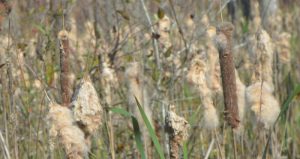By Les Harrison
Swaying Cattails
Cats are common in Florida. The domestic version of this multi-color and variable size species is a popular choice as a low maintenance pet.
A native aquatic plant curiously named for the feline’s longest appendage is a common sight in many ponds, swamps and backwaters. Fortunately for the resident rodents, a swaying cattail does not always mean impending doom by fang and claw from today’s listless couch ornament.
Gourmet meals in brightly illustrated containers were not how these mousers of yesteryear sustained themselves. It was easy to recognize a cat on the pursuit by the intense stare and the gently swishing sometime erect tail similar to cattails in a breeze.
Typha is the plant genus which includes about 30 species of cattails. They are found mostly in the northern hemisphere, but some species have been introduced to non-native area and are considered an exotic invasive plant.
Two Native Species Of Cattails
Florida has two native species of cattails. The common cattail (Typha latifolia ) and the southern cattail (Typha domingensis) are the two resident species.
Both species can reach eight feet or more in height and grow prolifically from thick, underground rhizomes. Given their aggressive growth rate, it is not unusual that cattails are the dominant plant species in marshes, retention ponds, and ditches where they establish dense concentrations of plants.
They can easily cover multiple acres in dense monocultures packed so tightly competing plants do not have the room to get established. Cattails are especially successful where water levels fluctuate which restrains the establishment of competitors.
Cattails get their common name from their cylindrical flower spikes which can be more than a foot long. Their bloom’s unique appearance is not easily mistaken for other aquatic plants either native or exotic.

Cat’s Furry Tail
The flower spikes are densely packed with tiny flowers and resemble, at a distance, a cat’s furry tail. If a gentle breeze sways the cattails, it is easy to see why the common name has entered universal acceptance.
Cattails flower in the spring and summer. The narrower, upper part of the spikes contains the male flowers and the bottom parts are the female flowers.
The hotdog-like seed head forms later in the summer. It is green when immature, but dries to a dark brown.
Each seed head contains approximately 220,000 seed which are attached to a fine downy material. As the seed head breaks up during the autumn, winter and early spring the seed are carried on the wind to new locations.
Cattail Plants For Food
Humans have long used cattail plant parts for food. The roots have a nutritional value similar to rice or corn.
The seed down is a favorite nest construction material of birds that inadvertently help spread the plant. Ironically, some rodent species will consume seed and plant parts, too.
When a cat’s tail or a cattail is swaying and a rodent is present, it will have either a very good day or its last one.
To learn more about cattails in Wakulla County, contact your UF/IFAS Wakulla Extension Office at 850-926-3931 or http://wakulla.ifas.ufl.edu/
 0
0

